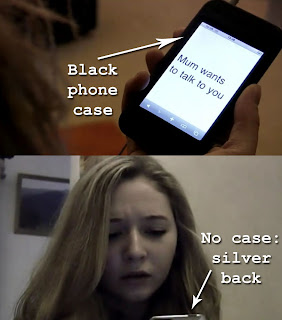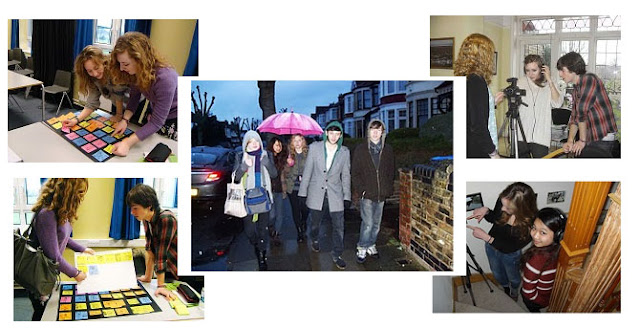Thursday, 7 April 2011
A Note to the Moderator
Hello! Thank you for taking the time to have a look around my AS-Media individual blog.
On the sidebar to the right, you can find links to my Main teaching blog, my Group Blog, and the list of labels for my posts to make it easy to navigate around my blog.
On this blog you can find individual research and planning which contributed to the overall project, and my answers to the 7 evaluation questions. It also contains my work and evaluation on our preliminary task, completed in preparation for my opening sequence. Both my preliminary task and finished opening sequence can be viewed at the top of the blog, at all times.
Our group blog contains all our combined work towards 'Mute' and you can see my individual contributions by clicking my name in the labels sidebar.
Thanks a lot for having a look around, and i really hope you enjoy my blog and particularly our opening sequence (which we worked very hard on!), 'Mute'.
Robbie Lardi
Candidate Number - 3400
Posted by Latymer Media 2010 at 05:09 0 comments
Tuesday, 5 April 2011
Evaluation Question 7

From the prelim task, we were extremely limited in our amount of editing time; we only had about an hour to edit it together. However, it was much more basic- the soundtrack and dialogue were very simple, it was only a minute long, and contains no fast paced action. Also, it was all shot within one room, meaning good continuity was easy to maintain as we kept the room exactly the same throughout the shoot.
It showed me just how long the editing process can take, and that you always need to allow much more time that you think is necessary. It also helped us understand how hard it is to create a seamless flowing narrative with limited editing time. Because of this we gave ourselves as much time as we could to edit our sequence together- more time means a higher quality product.
Here is a shot of our group working across the different stages of production:

Posted by Latymer Media 2010 at 02:59 0 comments
Labels: evaluation
Evaluation Question 6
6) What have you learnt about technologies from the process of constructing this product?
While already experienced in several areas of film production, i furthered and developed many skills while constructing our sequence, across all the hardware and software which we used.
Hardware
I knew how to handle a camera on a fairly basic level before this project, but now my competence with it has increased as we learnt new techniques to help make our project a success.
For the first time, we decided to change the manual settings of our camera instead of just leaving it on the 'auto' setting as we shot. We tried several techniques with the manual settings, changing the lighting, contrast and fps of our footage from the camera itself.
We learnt how to focus pull, and we thought it would look very professional to include a couple of focus pulls in our final sequence (which we did), and here is a short video of us practising different focus pulls:
Using a tripod and other camera attachments were fairly straightforward in this project; as much of our sequence was filmed handheld without a tripod. However, this did make some of our shots shakier than expected, something we did not intend.
While i did learn a lot about the hardware we were using, there were no huge leaps from using a camera and equipment before; so we did not find ourselves too challenged. However, we did really explore the creative possibilities that the new and exciting software could provide for our sequence.
Software
Adobe Premier Pro
The main editing software we used in our project. We had worked with Premier Pro before on our GCSE project, so i already had some experience, but i feel much more confident after spending several more weeks editing our sequence.
We also explored many techniques of editing and grading our footage, using two tools i had not used before: ProCamp and Three-Way Colour Corrector to help color grade our sequence, achieving the washed out colour palette often seen in action movies. We began with absolutely no experience of using these tools, effectively employing trial and error while working, but after weeks of work i would feel confident to work with them again.
We also improved our ability to equalize sound between shots, and to use the high-pass effect when Ava removes her headphones; making the transition between music and eerie silence as convincing and professional as possible.
Adobe After Effects
I had never used After Effects before, but we used to to apply the Degrainer effect to some of our footage, after we found it to be much grainier than we expected. This was probably because we filmed in a low light section of my house, and did not fully utilize the pag-light while filming.
We also used the software LiveType to help make our titles exactly how we wanted them; and to make them look as professional as possible.
If i was doing this project again, i would have fully utilized all the technology at my disposal, much like we did in this project. I would have tried to do a video storyboard and test shoot, which would have helped make the production process run as smoothly as possible.
Posted by Latymer Media 2010 at 02:30 0 comments
Labels: evaluation
Evaluation Question 5
5) How did you attract / address your audience?
We attracted our target audience of young people by using a young cast, with the three leads being teenagers. Teenagers can relate to our rebellious lead character, attempting to overthrow the oppressive government authority.
Our film has an edgy and contemporary style which would also hold strong appeal for a younger audience, the pacey editing and thrilling plotline is a good hook for a younger audience looking for thrills in a film. The heavy influence of technology in our film is also appealing for younger audiences, as they can relate to always being on their phones, and 'Mute' provides an insightful social commentary about this dystopian world where technology has taken over. Our storyline contains many conventions of an action film which would attract fans of the genre, such as chase scenes, a 'saving the world' scenario, and a lead hero to propel the narrative, but we think that teenagers want to see something fresh and exciting on their screens as well as the standard conventions of an action / drama film. To do this, we have an intelligent plot full of twists and turns, deaths of main characters, a partially unresolved ending and moments of shocking drama.
Being a British film, our primary national audience is Britain. We reflected this in 'Mute', most obviously by setting the film in London and having a predominantly British cast. This is furthered through our choice of music. Not only is drum and bass music such as ours mostly listened to by young people, it also holds strong British roots; you wouldn't find that music being produced in many other countries at all. It helps stick to our British brand identity, and will help attract a young British audience. The gritty style of 'Mute' is also something which our audience would relate to other popular independant British flicks or TV shows, such as Kidulthood (Huda, 2006) or Misfits (British TV Drama, 2009 - present).
We attempted to address the multi cultural aspect of modern day London by including actors of different races; caucasian British, Asian and African-American actors are all present in our sequence, which helps provide an accurate portrayal of London, and will help attract a racially diverse audience.
Posted by Latymer Media 2010 at 02:01 0 comments
Labels: evaluation
Monday, 4 April 2011
Evaluation Question 4
Posted by Latymer Media 2010 at 15:41 0 comments
Labels: evaluation
Evaluation Question 3
3) What kind of media institution might distribute your media product and why?
Our production company is called Binary Studios, and we specialise in gritty British drama's, often with elements of science fiction- such as the dystopian world of 'Mute'. Our films could be likened to other independant British productions such as This is England (Meadows, 2006) or Hot Fuzz (Wright, 2007).
British companies are not particularly famous for their action films, and 'Mute' attempts to challenge this convention by providing a large scale, action filled plot, but combined with the strong script, characters and distinctive style which has made British cinema so recognisable and successful in recent years.
Phoenix International are distributing 'Mute'. They are an international company as while 'Mute' remains firmly a British production, we believe it has global appeal due to it's interesting characters and accessible storyline; so is intended to be exhibited nationally to begin with, and then furthered with a limited global release.
An example of a real distributor who might distribute our film is Fox Searchlight Pictures, who do not distribute massive, epic movies such as Avatar (Cameron, 2009), but instead lean towards more independant and British productions such as Slumdog Millionaire (Boyle, 2008) and Sunshine (Boyle, 2007). The two films mentioned are also good examples of British made films which maintain global appeal.
Fox Searchlight pictures, being a division of the much larger conglomerate 20th Century Fox, would also be able to fund any future sequels or franchises if the film was a commercial success.
Posted by Latymer Media 2010 at 14:53 0 comments
Labels: evaluation
